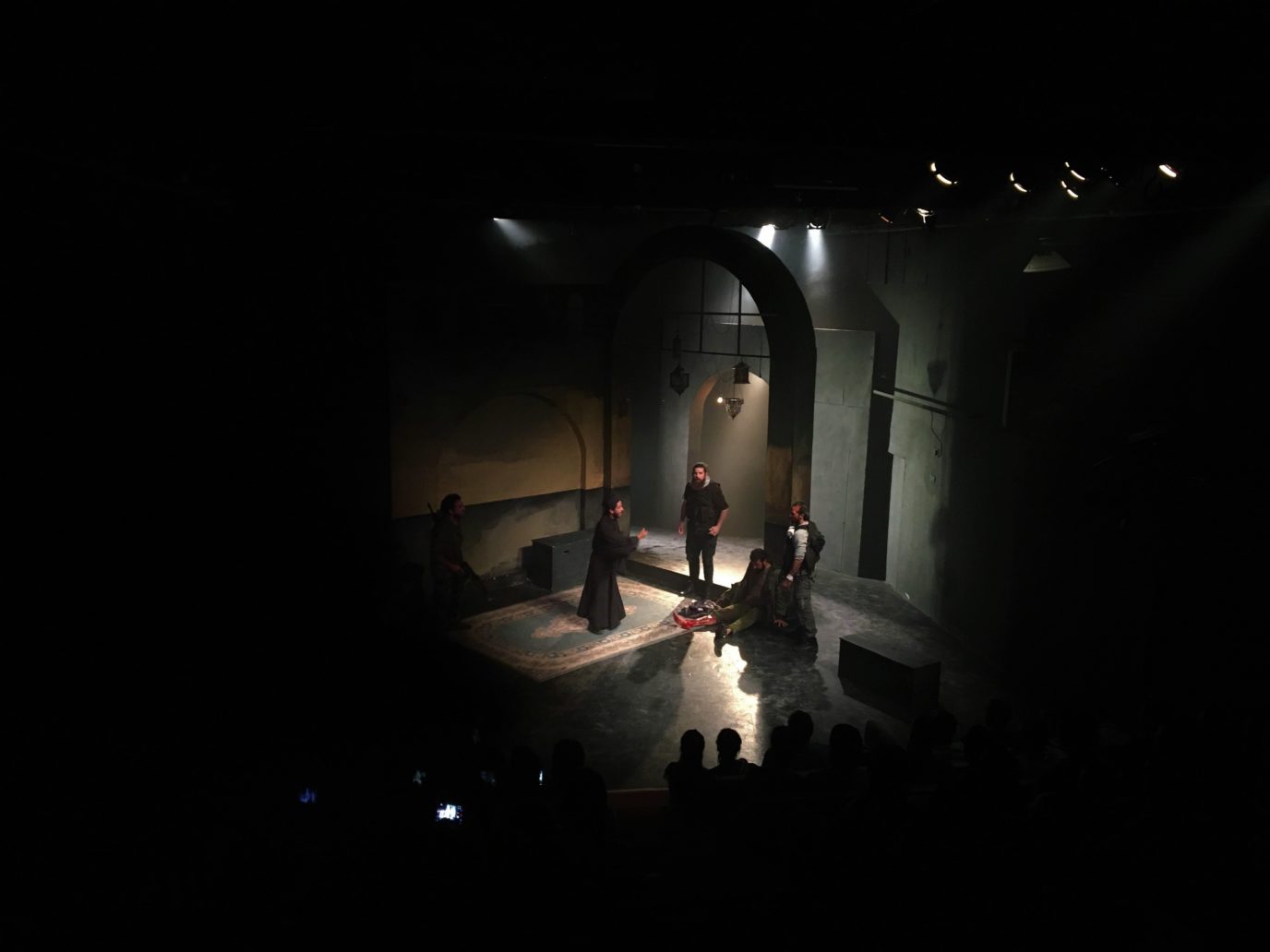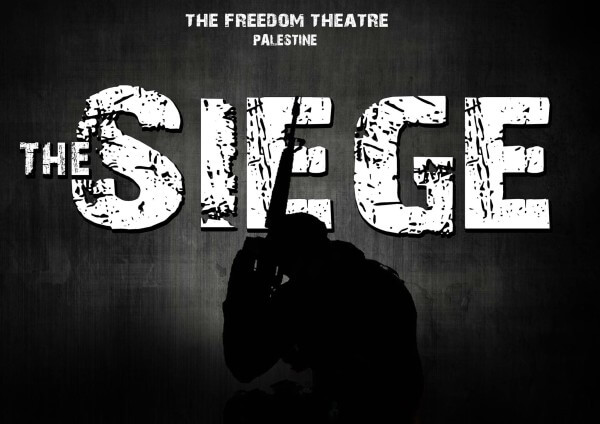Originally published by Ma’an News Agency on April 19, 2015.
JENIN (Ma’an) — In a small alley hidden among the hardscrabble streets of Jenin refugee camp, memories of the bloody Israeli siege of Palestine’s most famous church are being revived.
Unlike most memorials, however, this commemoration includes neither a march nor a statue. Instead, the attack on the Church of the Nativity in 2002 is being recounted in theatrical form, and the voices of the Palestinian fighters as well as the priests involved are being brought to the fore exactly 13 years later.
The play “The Siege” is a production of the Freedom Theater, one of Palestine’s most famous theater groups and a long time proponent of resistance against occupation through art.
With their latest work — which has toured the West Bank since its April 4 opening and is slated to reach the United Kingdom in the coming weeks — they hope to retell a story that once gripped the global public but which the directors say has been little understood until now.
Morality in warfare
“The Siege” focuses on the plight of five Palestinian fighters stuck in the Church of Nativity during the 39-day Israeli siege in April-May 2002. At the time, Israel was conducting a massive campaign against Palestinian resistance groups in the West Bank, and during the invasion of Bethlehem a few dozen armed men as well as policemen and civilians sought sanctuary in the Church, where 200 priests and other church officials were staying.
The church leaders accepted the request for sanctuary following an age-old custom, but the Israeli military shocked the world by responding with attacks on the ancient holy place that left eight dead, including a man shot and killed by a sniper while tolling the church bells.
At the end of the siege, which left the hundreds inside with little food or water and at constant risk of Israeli fire, the fighters were eventually pressured into accepting an agreement that forced them into exile.
The Siege explores the relationship of five fighters to one another, to the Israeli soldiers outside, as well as to the priests inside the church. The play also explicitly delves into deeper questions about the possibility of morality in warfare and interrogates each fighter individually, exploring his relationship to Palestine, to the struggle, and ultimately — when the decision to end the siege with exile occurs — to the very land itself.
As a result, The Siege treads on territory rarely explored, creating a space in which fighters are seen not only as idealized symbols of resistance, but as individuals, Muslim and Christian, making informed choices about how best to protect their families and who reflect upon their own relationship to life, death, and killing. A more complex image of Palestinian resistance emerges through the play, allowing the audience to reflect upon a movement that has long held widespread support among Palestinians of all faiths and creeds.


 ‘Why do people pick up arms in Palestine?’
‘Why do people pick up arms in Palestine?’
The play was created with both a local and British audience in mind, and the directors hope that it will force Western audiences to re-consider the view that Palestinians are merely “victims.”
“It’s a challenging piece because it looks at the reason for armed resistance and the right to defend yourself,” Zoe Lafferty, the co-director of the play and a British national who has been working with the Theater since 2010, told Ma’an.
In the United Kingdom, she added, “You can talk about bulldozed houses, you can talk about children dying in Gaza, … and you can talk about bombardments on Gaza. But no one will talk about why Hamas fires those rockets. No one wants to look at those subjects.”
“Why do people pick up arms in Palestine? It’s not because they’re crazy religious fanatics as is always said, it’s because there is a deep wish to defend their families,” she added.
Lafferty told Ma’an that the play forces international audiences to re-consider their understandings of resistance in the Palestinian context. It prominently features Palestinian fighters who are both Muslims and Christians, mirroring the actual diversity of Palestinian armed groups, but challenging the commonly-held notion in the West that all Palestinian fighters are Muslim.
“Christian Palestinians are never spoken about even though they obviously live under the same occupation and live the same conflict and horrendous situation,” she told Ma’an.
“But no one ever wants to acknowledge that they’re Christian, because (if you do) you’re immediately debunking the propaganda that this is all just some ‘Islamic madness,'” she added.
“It’s a challenging piece for an international audience, and by being challenging it brings new layers of understanding to the situation.”
Lafferty added that the directors spoke with monks who had been in the Church during the siege as part of the research for the play, and they hoped to challenge Israeli propaganda — which painted the church officials as “hostages” of “Muslim terrorists.” The monks, she said, lived the same situation as Palestinians and were far more sympathetic to local freedom-fighters than to the army bombarding them.
“The West loves to see the Palestinians who are victims, but it’s much more complex than that. Despite the fact that Israel has the 4th strongest army in the world, Palestinians are strong and brave,” Lafferty told Ma’an.

’We need to stop and think’
The show’s run in the West Bank was successful, playing to large crowds not only in Jenin but also in theaters in Bethlehem and Ramallah.
The large number of showings allowed the production to reach audiences not often able to attend the theater, including one Jenin performance Ma’an saw where more than 100 local school girls attended.
The play kept the young crowd in rapt attention throughout its ninety-minute run, a feat accomplished in no small part due to the strapping male actors leading the audience through the scenes.
For many of the school girls, it was probably their first in a play, and perhaps even their first time in a church, albeit a fake one. The narrator instructed them early on in proper behavior inside a Christian holy place, and by the time the fighters entered the church in flight from the Israeli army, the entire room was dead silent, the girls’ undivided attention concentrated on the scene unfolding before them.
And while the United Kingdom may be the play’s next destination, for the directors, the play is as much about reaching Palestinians as it is about reaching audiences abroad.
Co-director Nabil al-Raee told Ma’an that as a result of the play, many in the community had a growing appreciation for the Freedom Theater, and he noted that even members of parties that look askance at the idea of theater were drumming up support for The Siege.
For him, the attempts in the play by fighters to not only liberate their land but also wrestle with broader moral questions is “an example of how things should be,” and a reason for its positive reception.”It’s not perfection, but the discussion of all of these different elements in the play makes you think, and that’s exactly what we need to do: stop and think.”
“We have a catastrophe, a drama, that has never stopped. We are always in a hurry to continue our work, and this is the Palestinian situation in general: we never stop, we never think and evaluate and try to ask what is wrong with what we are doing and how to bring ourselves back to where we need to be.”
“This play is an attempt to get people to come back and think.”
